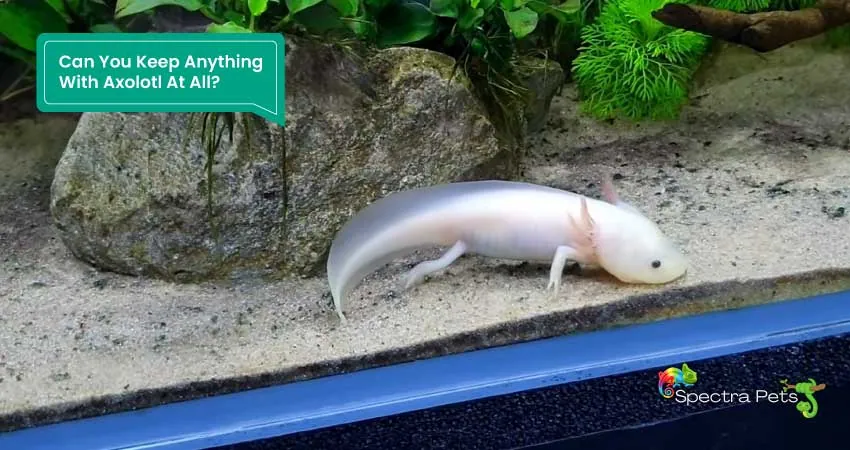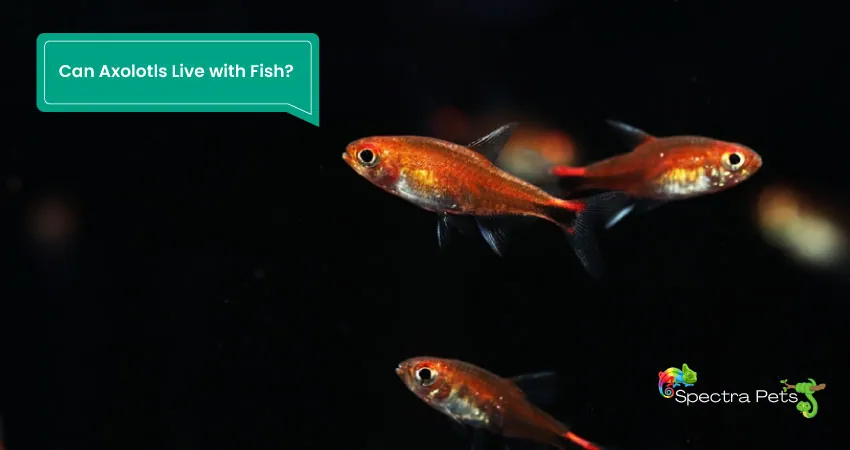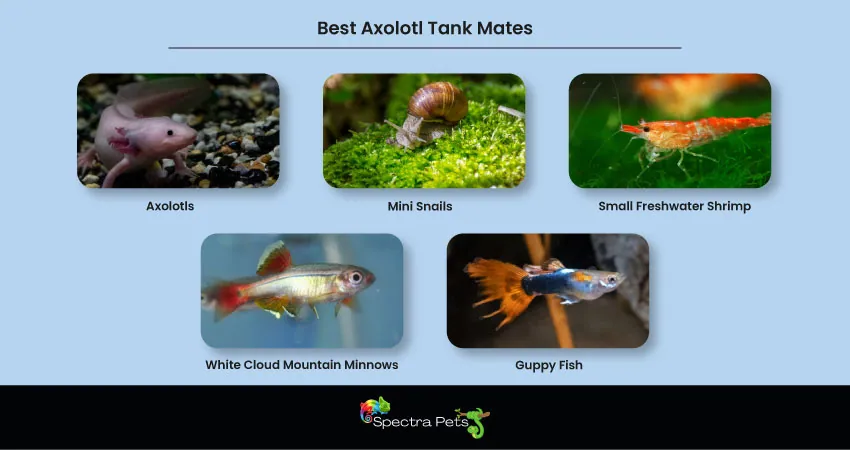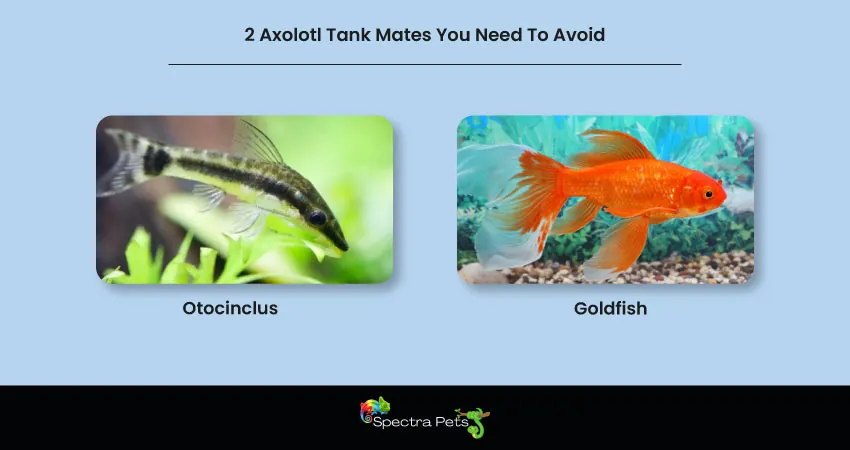Are you an axolotl owner looking to give your water-loving pet some companionship? I understand why you would want to add another aquatic resident to the tank, but can two or more aquatic animals live harmoniously together with an axolotl?
There is a genuine reason for your concern. Considering how solitary these amphibians are, they might prefer being alone. Fear not: if you have a large enough habitat and follow some simple guidelines, you can house another aquatic species alongside your beloved pet.
You can house them with another axolotl, that’s the best case. Otherwise, snails, freshwater shrimp or guppy fish are also great tank mates.
I’ve got more details for you down below…
Can You Keep Anything With Axolotl At All?

Well, technically, you can house your axolotls with selected aquatic species. But I would not recommend it. Given their fragile nature, not all popular aquatic pets are the best to house with these ambystomas.
There are concrete reasons why you should house your axolotl alone, as I shall explain to you later on.
Important Things To Remember Before Bringing In A Tank Mate For Axolotls
Before bringing in other animals to live together with your pet walking fish, you need to be mindful of a few things first:
- Make sure that the animal of your choice has basic compatibility with your axolotl (as in water conditions, temperatures, etc.).
- You must have a large enough aquarium, where all the mates are going to have ample space to live happily.
- Verify the nature of the animal. Avoid any species that are listed as aggressive.
- Consider the size of the animals. An animal too small will potentially end up in the axolotl’s belly, and one too large may attack it.
- Quarantine any animal you acquire for at least 14 days in order to prevent any bacterial, fungal, or parasitic illnesses.
Can Axolotls Live with Fish?

So, naturally, you might wonder if fish can live together with axolotls.
In the wild, both of these creatures live in the same body of water, as it is their natural habitat. But, things get way more complicated if you are intending to house them together in a captive environment.
Well, axolotls have specific needs in terms of the environment. These amphibians are cold water creatures, and thus only cold water fish can coexist with them.
Afterwards, there are compatibility issues. The size and nature of the fish are quite important in this. If the fish is too small, the ambystoma will try to make its dinner out of it. Moreover, fish with an aggressive nature will constantly nibble the axolotl, which will induce stress in the animal and may also cause physical harm to it.
Last but not least, you will have a difficult time feeding a community tank of axolotls and other fish. The amphibian will be dwelling on the surface, and the fish will be swimming at the top. Any food that you provide will first reach the fish, and opportunistic feeders will eat them all away before the food even reaches the poor ambystoma. Sure, there are ways to get around it, but it is such a hassle.
Best Axolotl Tank Mates

Axolotls are solitary creatures that like to keep to themselves. The only other times they interact with other animals are during mating season and if they are hunting live animals for food.
There are some obvious options and some that are a poor choice when it comes to choosing tank mates. If you are oblivious to the warnings and still determined to introduce tankmates to your goofy pet, then there is a good variety that you can choose from.
Let’s have a look at the best choices to keep with an axolotl in the same tank:
1. More Axolotls
The best partners to house in the same aquarium with an axolotl are, well, other axolotls! Usually, an individual axolotl will only interact with another of a different sex. This is because of their mating instincts. Other than that, they like to live by themselves.
Before bringing in another axolotl, you must consider its size and gender.
A larger walking fish will almost always outcompete the smaller one for food. It will also potentially bully the smaller one. This will induce stress in the smaller animal, which is harmful to its health.
You can keep axolotls of different genders together as well. However, even under captive care, these creatures can reproduce easily. The female may lay up to 1,000 eggs at a time. So, unless you want this to happen, this might not be a good idea.
Additionally, you need to keep cannibalism in mind. Sometimes a hungry axolotl will attempt to eat its own mate from the same species! Even if they are not fully successful, they will certainly leave behind injuries.
This cannibalistic nature is seen more frequently in animals that are in their juvenile phase. Adults usually do not show such behavior.
Therefore, you need to make sure you have a large enough aquarium where they can both live comfortably by themselves.
2. Mini Snails
Small coldwater snails are a favorite as an axolotl companion for many owners. In terms of appearance, they are quite striking, and they have a very amiable personality.
The fact that the snails are bottom feeders is a great additional benefit. Leftover foods in the tank will usually see a growth in bacteria. But the snails will eat up any leftover food that has reached the bottom, which will aid in keeping the tank clean. This also keeps the ammonia levels in the water under control.
Their size also allows the axolotls to swallow them whole, should the situation arise. Therefore, there is a lesser risk of choking hazard.
Do keep in mind that many popular aquarium snails have a soft exoskeleton. There is always the risk of the outer shell damaging the amphibians’ internal organs should they swallow them.
Also, many snail species tend to grow pretty large. If you notice them getting bigger, it is best to remove them.
Some popular mini snail species are:
- Ramshorn snails
- Apple snails
- Bladder snails
- Nerite snails
- Rabbit snails
- Gold inca snails
- Mystery snails
3. Small Freshwater Shrimp
The majority of shrimp can endure in the same axolotl-friendly water parameters. Additionally, shrimp enjoy tanks with a lot of live plants and prefer to stay on the substrate, just like the walking fish.
In general, shrimp are very calm. Given the nature of axolotls, it is unlikely that these two creatures will have a go at each other.
Additionally, even though both of them are scavengers as well as bottom feeders, axolotls and shrimp have a different diet. This means that they will never compete with each other for food.
Some popular small shrimps are:
- Ghost shrimp
- Bamboo shrimp
- Caridina shrimp
- Amano shrimp
- Blue velvet shrimp
- Vampire shrimp
- White pearl shrimp
4. White Cloud Mountain Minnows
Axolotls can get along well in tanks with white cloud minnows because they are calm, cool-water fish. They are very vibrant in terms of appearance, and will constantly swim around the tank.
Because they don’t have spines or shells, they are safe for your pet amphibians to consume. They will occasionally be eaten, even though that may not be your intention.
Your axolotl will inevitably hunt these fish down, and there is not really much you can do about it. Fortunately, white minnows are very quick swimmers, contrary to walking fish, which generally swim at a much slower pace. This will allow the fish to easily get away from the grasp of the amphibian, unless they get caught off guard.
5. Guppy Fish
Guppies are also small fish that feed at the bottom of the tank. These fish do quite a good job of coexisting with an axolotl.
This species of fish lacks an exoskeleton, which allows them to be wholly swallowed by your pet amphibian as well.
However, these fish are also very reproductive. Soon there will be guppy fry swarming your tank. Also, they will occasionally nibble away at the amphibian’s gills.
Even though the ones that I have mentioned above aren’t exactly risk-free choices, there are 3 other animals that you must avoid housing with the Mexican walking fish. I have discussed more about this down below:
2 Axolotl Tank Mates You Need To Avoid

1. Goldfish
Goldfish, given their vast popularity, is a fish that most people would consider as a tank mate in any tank setup in the world. However, it is totally not recommended to put axolotls and goldfish together, and here’s why:
Goldfish start out as quite small fish, but they can easily get as big as 12 inches (which is about the same size as your axolotl). As your axolotl will inevitably try to swallow the fish, they may get impaction.
Additionally, goldfish are pretty aggressive fish. They will try chipping away at the amphibian, which will leave the animal injured and stressed. These fish also produce a lot of waste, which will often result in a messy tank that you need to clean way more often.
Lastly, goldfish swim at the top of the tank and are opportunistic feeders. They will eat away all the food intended for the axolotls, as the axolotls are bottom dwellers and slow swimmers.
2. Otocinclus and Cory Catfish
Given their smaller appearances, many people consider both Otocinclus and Cory catfish as good tankmates for the Mexican walking fish. This is definitely not the case, though.
Both of these fish have spiky defensive spines on their dorsal and pectoral fins. This will easily pierce the mouth and the internal organs of the axolotls, as they only swallow their food whole and do not chew on it.
The worst part is that the smaller appearance gives the impression of being easy prey. This means that your axolotl will hunt them down and injure itself in the process.
Downsides Of Having A Tank Mate With Axolotls
Here are the downsides of having a tankmate with these Mexican amphibians. This might make you have second thoughts:
Fragility
Axolotls are infamous for being extremely fragile. They can easily get hurt by the slightest careless touch. As you introduce other animals to the tank, there is always a possibility that they will collide with each other.
While these amphibians do have regenerative abilities, they can get various infections, parasites, and bacterial diseases from other tankmates as well. These can prove to be fatal for the poor ambystoma.
Impaction
Impaction is something you also need to consider before introducing tankmates to your pet amphibians. Since they are carnivores, these creatures will attempt to consume any fish or tiny crustaceans that they can swallow whole.
In other words, you can pretty much give up on the idea of your walking fish and small fish living together in harmony. Your axolotl will simply eat them up.
The amphibian will continue to attempt to eat the fish whole even if they are not successful. This could potentially lead to choking or impaction. If the fish is not small enough to be swallowed whole, it will be swallowed only half-way, and the axolotl will begin to choke on it.
Diseases
In addition to the problems mentioned above, there is always the risk of disease spreading between all the tank mates. Animals gathered from various sources can get different types of disease, so quarantining them for a couple of weeks is always a great idea.
Judging from the aforementioned factors, you might want to reconsider bringing in other animals in your axolotl tank.
Frequently Asked Questions (FAQs)
Can Axolotls Live With Turtles?
Turtles are cold-blooded reptiles that need very warm water temperatures in order to live. This makes them completely incompatible with axolotls, which cannot live in water that is warmer than 18° C.
Moreover, turtles, by nature, are pretty aggressive creatures. They are also physically more dominant and can kill an axolotl very easily.
Can You Keep Axolotls With Cichlids?
Absolutely not. Most cichlids require a different tank setup than that for an axolotl. Additionally, these fish are quite aggressive by nature and tend to nip at flowy fins and gills.
Can Axolotls Live With Betta Fish?
Betta fish are also warmwater fish, which makes them incompatible with axolotls. Also, given their size, the amphibian will easily prey on the betta.
Can You Keep Frogs With Your Axolotls?
Frogs and axolotls are not compatible with each other at all. Most frogs require a higher water temperature (about 24 °C), which is too much for axolotls to survive.
Other than that, frogs can carry various diseases and parasites that spread easily and can be deadly for the Mexican walking fish.
Wrapping Things Up
As you may have noticed, even the best choices for tankmates come with a significant disadvantage. This is why I would recommend having a solitary tank just for the axolotl itself. If you insist on giving them a tank mate, be sure to monitor them carefully and remove the other animal if it seems like they are stressing out your little friend.

